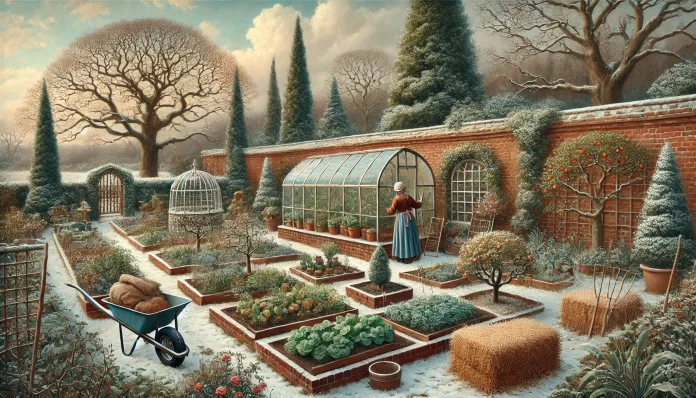Winter is often seen as a quiet time in the garden, but for gardeners on historic estates, it was a season of meticulous preparation and hard work. Drawing from centuries-old practices, these techniques not only preserved the beauty of the gardens but also laid the groundwork for a productive spring. Here, we explore some traditional winter gardening methods still relevant today.
1. Wall Fruit Protection
In the grand gardens of old estates, fruit trees such as peaches, apricots, and figs were often grown against sun-warmed brick walls. These “fruit walls” created a microclimate, extending the growing season. During winter, gardeners would protect the trees with hessian sacking or straw mats to shield them from frost.
Modern Tip: If you grow wall-trained fruit trees, consider using fleece or bubble wrap over the roots and base in severe weather. Adding mulch also helps insulate the soil.
2. Using Cloches and Bell Jars
Victorian gardeners were experts at creating mini-greenhouses. Glass cloches and bell jars were used to protect tender crops like winter lettuces and young brassicas. This method allowed fresh vegetables to be harvested even during the colder months.
Modern Tip: While original glass cloches are rare (and fragile), plastic or polycarbonate alternatives are affordable and effective for frost protection and early sowing.
3. Building and Maintaining Hotbeds
Hotbeds—frames filled with decomposing manure—were an essential feature of old estate gardens. The heat generated by the manure allowed gardeners to grow crops like melons and early cucumbers, even in winter.
Modern Tip: You can recreate a hotbed by layering fresh manure under a raised bed or cold frame. It’s an excellent way to experiment with early sowing while recycling organic materials.
4. Winter Pruning for Shape and Health
Traditional estate gardeners pruned fruit trees, roses, and ornamental shrubs during dormancy to maintain their form and encourage better growth in the spring. The structured appearance of walled kitchen gardens and orchards reflected this careful attention.
Modern Tip: Winter is still the best time to prune deciduous trees and shrubs when their structure is visible. Use sharp tools and clean cuts to avoid damaging the plant.
5. Cleaning and Storing Tools
With fewer planting tasks in winter, estate gardeners focused on maintaining their tools. Blades were sharpened, wooden handles were oiled, and tools were stored in a dry place to prevent rust. This ensured they were ready for the heavy use of spring and summer.
Modern Tip: Invest time in cleaning your tools during winter. It extends their life and improves their efficiency. If you have a greenhouse or shed, create a dedicated area for tool maintenance.
6. Protecting Perennials with Straw and Mats
Tender perennials were often lifted and stored in frost-free conditions, while others were protected in situ with straw or bracken. Estate gardeners would sometimes construct temporary shelters, such as straw mats tied around the base of plants or protective cages filled with leaves.
Modern Tip: Use horticultural fleece, straw, or leaf mold to insulate tender plants. Potted perennials can be moved to a sheltered location, such as a greenhouse or porch.
7. Planting Bare-Root Trees and Shrubs
Winter was the ideal time for estate gardeners to plant bare-root hedging, trees, and fruit bushes. The dormant plants established quickly in the cold, moist soil and were ready to grow vigorously in spring.
Modern Tip: Bare-root plants are still a cost-effective and sustainable way to establish trees and shrubs. Plant them as soon as possible after purchase, ensuring the roots are kept moist.
8. Preparing Soil for Spring
In traditional estate gardens, winter was a time to dig over heavy soils, incorporating manure or compost. This allowed frosts to break down clumps of soil, creating a fine tilth for spring planting.
Modern Tip: If your soil is heavy clay, dig it over in winter to allow frost action to improve its structure. For lighter soils, consider adding organic matter to replenish nutrients.
9. Preserving Seeds and Bulbs
Historic gardeners would carefully store seeds and bulbs over winter to ensure a plentiful supply for spring. Seeds were kept in paper packets in cool, dry places, while bulbs were checked regularly to prevent rot.
Modern Tip: Store your seeds in an airtight container with silica gel packets to keep them dry. Bulbs should be kept in a cool, ventilated area away from pests.
10. Training Apprentices
Winter provided estate gardeners with time to train apprentices, passing down skills like pruning, grafting, and soil preparation. This ensured the continuity of traditional methods across generations.
Modern Tip: Whether you’re mentoring a young gardener or learning a new skill yourself, use the quieter months to invest in education. Attend workshops, read gardening books, or practice techniques like grafting.
Conclusion
The traditional winter gardening techniques of estate gardeners remain as valuable today as they were centuries ago. By adapting these methods, you can ensure your garden stays productive and beautiful throughout the cold season—and be fully prepared for the arrival of spring.




